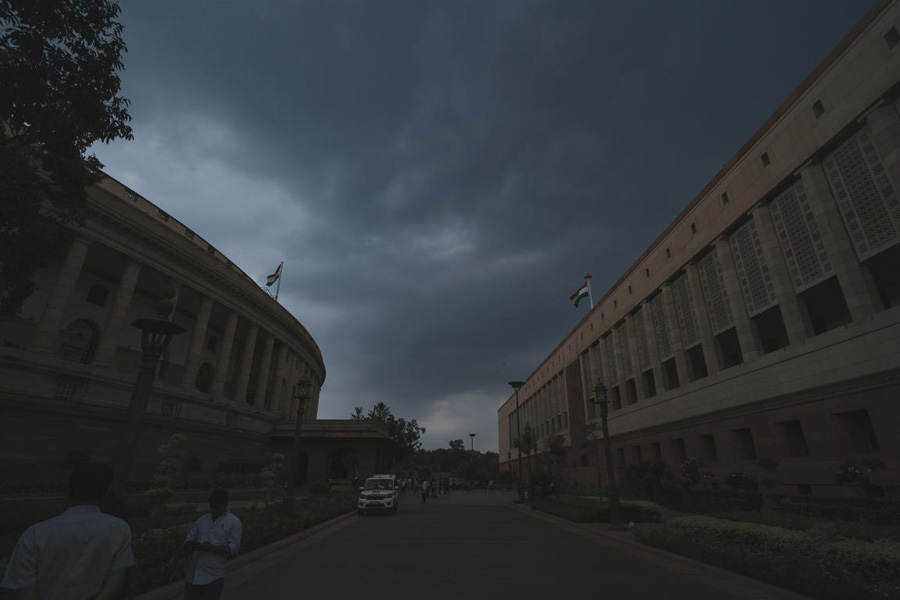A legend of the forest worshipped by Hindus and Muslims alike has been instrumental in not letting communal tension come to the forefront in the Sunderbans, feels the author who has introduced the legend to the world.
Legends like this make the popular culture of Bengal so mixed, vibrant and interesting, the author said.
A virtual session at the Tata Steel Kolkata Literary Meet in association with Victoria Memorial Hall and The Telegraph saw Amitav Ghosh discuss his new book Jungle Nama, due for a mid-February release, with journalist Ankita Mukherji.
The book is a verse adaptation of an episode from the legend of Bon Bibi, a tale popular in the Sunderbans, which also lies at the heart of Ghosh’s earlier novel, The Hungry Tide.
Bon Bibi is believed to have travelled from Medina to the Sunderbans to protect the people as well the forests and its animals. Her legend has survived through handwritten manuscripts and orally, through pala-gans and jatras.
The book has been illustrated — “illuminated”, says Ghosh — by artist Salman Toor, born in Pakistan and based in New York.
“It is a miracle that he can actually join us because there is a huge snowstorm that is headed to New York, which is where he is trying to drive down to at this point,” Mukherji said at the outset.
Excerpts from the conversation.
Protector, of communal harmony Mukherji wanted to know if it was “more important than ever before to reclaim syncretic figures like the Bon Bibi for the present generation”.
Ghosh called the Bon Bibi legend “extra-ordinarily hybrid”.
“Bon Bibi is the daughter of a Muslim fakir who goes to Medina. She is born in Medina. From Medina, she comes to Bengal. Hindus may see her as a goddess and Muslims will see her as a female peer. All across the Muslim world, there used to be saint figures who had magical powers. We have a very rich tradition of this kind of syncretic folklore in Bengal,” he said.
“All across the Sunderbans, rituals to Bon Bibi are performed by Hindus as well as Muslims. All these rituals begin with Arabic incantations. That’s a common feature: Hindus do it, Muslims do it just as much. I think it is a wonderful kind of syncretism that you see there. In popular culture, in Bengal, it is incredibly mixed. These traditions, they are impossible to pick apart and say this is Hindu and this is Muslim. There is just so much mixed together. I think that’s what makes the popular culture of Bengal so vibrant and so interesting,” he added.
“Shrines to Bon Bibi are just little things that people make out of wood and bamboo…. One of the most important aspects of the culture of forest people everywhere is that they don’t build temples. Historically, what they would do is they would create shrines within the forest. A temple, a mosque, a church — what do they do? They create a structure that cuts you off from your surroundings. Whereas the whole idea of forest belief is that the forest itself is your temple, the forest itself is your shrine.
“Unfortunately, I think people will start building temples to Bon Bibi,” said Ghosh.
For several years now, there have been reports from the Sunderbans of a persistent attack on the syncretic character of Bon Bibi. Several people are said to be unhappy with the cross-communal name and prefer Bonodebi. Temples to Hindu deities have also replaced shrines to Bon Bibi at several places.
On Saturday, when Ghosh spoke of temples to Bon Bibi, Mukherji said they already exist.
“That might be a sign of the times because temples do tend to proliferate everywhere these days…. There have been so many instances of disruptions in communal harmony but not in the Sunderbans area. Do you think Bon Bibi might have a role in that?” she asked.
Ghosh’s answer: “Absolutely. Look, let us not idealise it. It’s not as if there are no communal tensions. Divisions are always rife for exploitation by politicians or people trying to take advantage of these things. But most of the people who live in the Sunderbans, especially on the Indian side, most of them are Dalits. There is an absolute overlap between the populations, there is a sort of neutral understanding. These kinds of communal tensions haven’t been at the forefront certainly in the Sunderbans. We should be very grateful. Yes, I do feel that Bon Bibi legend has something to do with it, absolutely”.
Bull’s eye: Balance
Ghosh called the Bon Bibi legend “a part of everyday life” in the delta.
“It is a kind of a charter of conduct for the people who live in the Sunderbans. The legend is really about finding a balance. A balance between the needs of the human and the needs of the non-human. This is basically what Bon Bibi does. She creates a balance between tigers and all other beings and humans. In that sense, I think it is a very apt legend for today. The moral of it is right on the mark, because of the problem with our world today. It is really that it’s a world out of balance. It’s a world where humans have just taken everything over and left nothing for the non-humans. Mind you, the non-humans aren’t taking it lightly. They are striking back. That’s exactly what we are seeing,” he said.
Incredible devastation
The mangrove delta is at the heart of several works of Ghosh. “What is in this very inhospitable terrain that keeps calling out to you and provides literary inspiration?” Mukherji asked him.
“Sunderbans is a meeting place. A place where land and water meet, where many rivers meet. One of the most spectacular things — confluence of rivers (mohona). It is not an untouched wilderness. A place with a very deep history. The workings of this history are quite visible within the forest. It was in the Sunderbans that I started to really get a sense of the incredible devastation that climate change is going to inflict upon the whole planet. Because the impacts are already visible there,” he said.











